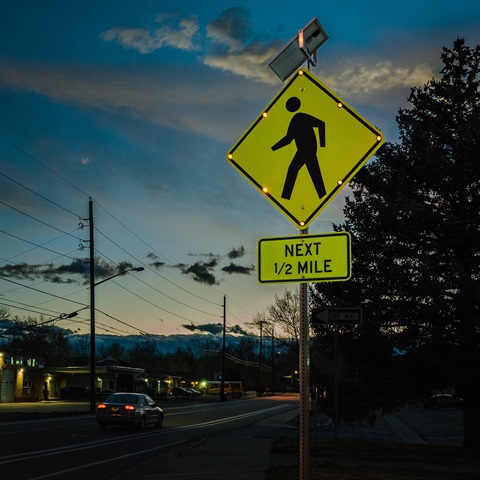New flashing beacons help keep pedestrians safe

March 25, 2025 - One of Lakewood’s busier pedestrian corridors now features enhanced safety elements. New high visibility, flashing beacons are in place along West 14th Avenue between Wadsworth Boulevard and Garrison Street after months of planning and installation, and they have been placed at key entry points and high-risk areas to emphasize nighttime pedestrian activity and alert motorists to be vigilant.
A fatal auto-pedestrian crash in July 2024, along with several other serious crashes in the area, provided the impetus for staff to take a closer look at how to prevent similar tragedies. This project also serves as an example of how Lakewood staff members put their professional expertise and perspectives together to make a difference in the community.
“The need for these signs became evident after multiple pedestrian-involved crashes, often involving individuals experiencing homelessness or struggling with substance abuse or mental health crises,” said Lakewood Traffic Engineering Operations Manager Matt Duncan.
While Duncan visits all fatal crash sites within 48 hours to assess safety needs, this situation called for more work. In the aftermath of the fatal July 2024 crash, Duncan visited the area with members of the Lakewood Police Department’s Community Action Team. He went on a ride-along with a police agent and the city’s homeless navigator, which provided a new perspective.
“Projects like these highlight that police officers don’t just write tickets,” Duncan said. “Their investigative insight and community outreach efforts are something I rely on and integrate with my engineering expertise to try to prevent this very complex category of crashes.”
Duncan also conducted several late-night drives himself. On one particular night, he observed 18 pedestrians walking in the roadway, including two families with children, in just a half-mile stretch. Many wore dark clothing, making them nearly invisible to drivers.
Adding to these safety hazards is the lack of sidewalks along West 14th and the number of residents accessing mental health, housing and other support services in the area.
Duncan, along with colleagues Keith Goates, Doyle Velasquez, Terri Haley and Aaron Foltz, began working on a multifaceted solution, including enhanced lighting, signage and finally the installation of the flashing beacons. The lighting work included coordinating with Xcel Energy to repair outages, adjusting streetlight angles, and conducting a lighting analysis for future solar-powered installations. The beacon placement addressed nighttime pedestrian activity, and the beacons were strategically placed to maximize effectiveness and visibility, specifically targeting nighttime pedestrian activity.
While these engineering changes should make things safer for drivers and pedestrians alike, outreach efforts from the CAT Team and Lakewood’s homeless navigators will continue to address some of the root causes of unpredictable pedestrian behavior. Additionally, prioritizing sidewalk projects to serve vulnerable pedestrians will be essential for long-term safety needs.
This project also led Duncan to work with Lakewood Detectives Jim Moffat and Greg Strandberg to identify other areas in the city where pedestrian-vehicle crashes are disproportionately occurring at night. Staff also connected with the Jefferson County Coroner’s Office to analyze pedestrian fatalities in nearly 40 cases, revealing that crashes were occurring at night between intersections, with the driver sober and driving reasonably, but simply were unable to see the pedestrian in an unlit or shadowed area of the roadway.
As a result, the city recently applied for over $1.83 million in streetlighting upgrades through the Colorado Department of Transportation’s Highway Safety Improvement Program for corridors with a disproportionate number of nighttime vehicle-pedestrian crashes. These corridors include Kipling Parkway from West Sixth to West 26th avenues and Wadsworth from West Jewell to West 26th avenues. Both Wadsworth and Kipling are state highways, and CDOT is expected to announce grant approvals this spring.
“In some segments of road, our analysis has shown that every $1 CDOT invests in improved lighting can yield more than $100 in crash prevention savings,” Duncan said, benefiting all residents who walk, cycle, or drive along these corridors.
One of Duncan's key messages for residents from this project is the importance of staying focused on the road ahead, particularly at midnight when it’s easy to assume the streets are empty. It’s also a time for drivers to be tempted to check a phone, drive while drowsy or get behind the wheel after a few drinks. But he said staying alert and vigilant is crucial to avoiding unexpected crashes because no one wants to live with the trauma of hitting another person.